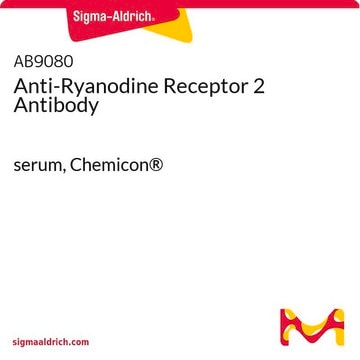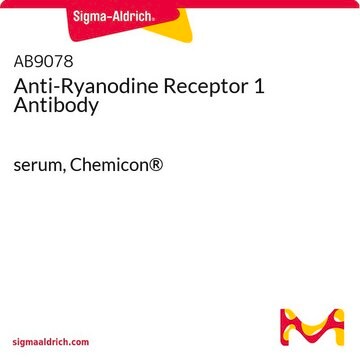MAB3086
Anti-Ryanodine Receptor Antibody, clone RYR.1
clone RYR.1, Chemicon®, from mouse
About This Item
Recommended Products
biological source
mouse
Quality Level
antibody form
purified immunoglobulin
antibody product type
primary antibodies
clone
RYR.1, monoclonal
species reactivity
rat, human, mouse, pig, bovine, canine
manufacturer/tradename
Chemicon®
technique(s)
ELISA: suitable
flow cytometry: suitable
immunocytochemistry: suitable
immunohistochemistry: suitable
immunoprecipitation (IP): suitable
radioimmunoassay: suitable
western blot: suitable
isotype
IgG2b
NCBI accession no.
UniProt accession no.
shipped in
dry ice
target post-translational modification
unmodified
Gene Information
human ... RYR1(6261)
Specificity
Immunogen
Application
Immunocytochemistry: 1:100 by indirect immunofluorescence. Visualization by confocal microscopy is required, as detection by standard fluorescent microscopy will not be adequate to detect the RyR. Additionally, fluorescent, not enzymatic, detection is required. Due to the intensity of confocal lasers, use of an anti-fading agent, such as DABCO, is strongly recommended.
Immunoprecipitation: 1:100
Flow cytometry: 1:500
ELISA: 1:1000
Immunohistochemistry: 1:100
RIA: 1:5000
Optimal working dilutions must be determined by the end user.
Neuroscience
Ion Channels & Transporters
Signaling Neuroscience
Physical form
Storage and Stability
Other Notes
Legal Information
Disclaimer
Not finding the right product?
Try our Product Selector Tool.
Storage Class
12 - Non Combustible Liquids
wgk_germany
WGK 2
flash_point_f
Not applicable
flash_point_c
Not applicable
Certificates of Analysis (COA)
Search for Certificates of Analysis (COA) by entering the products Lot/Batch Number. Lot and Batch Numbers can be found on a product’s label following the words ‘Lot’ or ‘Batch’.
Already Own This Product?
Find documentation for the products that you have recently purchased in the Document Library.
Our team of scientists has experience in all areas of research including Life Science, Material Science, Chemical Synthesis, Chromatography, Analytical and many others.
Contact Technical Service






